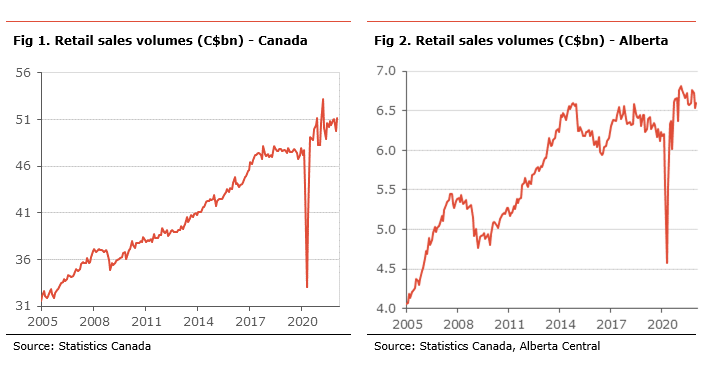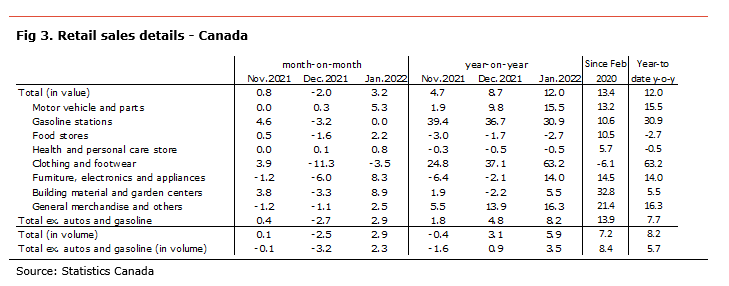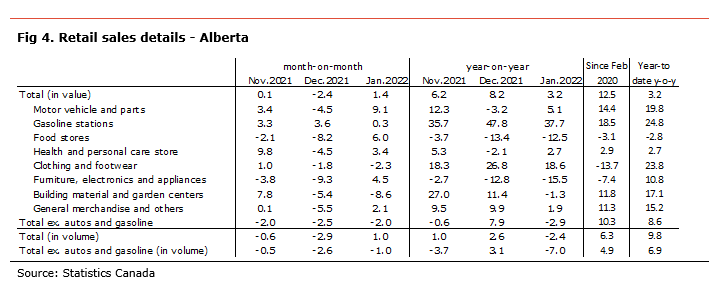Economic insight provided by Alberta Central Chief Economist Charles St-Arnaud.
Bottom line
Retail sales recovered in January as restrictions to slow the spread of Omicron were lifted. However, the preliminary estimate for February shows a small decline, suggesting some headwinds on consumer retail spending. Supply chain woes could continue to somewhat hold back retail sales in the coming months. In addition, a return to more normal spending behaviour could also lead to an underperformance in retail sales, as spending shifts from goods to services (restaurants, bars, personal care, etc).
In Alberta, retail sales performance shows some signs of underperformance relative to the rest of the country. We note that core retail sales, which exclude motor vehicles dealers and gasoline stations, have declined for three consecutive months, suggesting some weakness in underlying retail sales. In its too soon to say whether this is due to consumer restraining their purchases or redirecting their spending toward sectors not included in retail sales, such as travel service, restaurants, entertainment, etc. We also note a divergence in retail sales between the metropolitan areas and the rest of the province, with sales stronger in Calgary and Edmonton. This could be explained by stronger employment gains in the metropolitan areas relative to the rest of the province.
The outlook for retail sales and consumer spending more broadly remains uncertain. On one side, consumers’ finances are being squeezed by an erosion in purchasing power due to high inflation, rising interest rates and a normalization in disposable income. On the other side, households have accumulated a significant amount in saving during the pandemic. Whether they spend it or keep it as precautionary saving or to repay their debt will matter for the outlook.
Retail sales rose by 3.2% m-o-m in January, following a downwardly revised decline in December of -2.0% m-o-m. Compared to the same month last year, retail sales rose +12.0% y-o-y. The level of retail sales is 13.4% above its pre-pandemic level. Statistics Canada also reports that retail sales eased by 0.5% in February based on a preliminary estimate.
Monthly sales increased in 9 out of 11 subsectors. On the month, the rise in retail sales resulted mainly from higher sales motor vehicle and parts (+5.3% m-o-m), furniture, electronics and appliance stores (+8.3% m-o-m), building material and garden centers (+8.9% m-o-m), food stores (+2.2% m-o-m), and general merchandise stores (+2.9% m-o-m). The sectors with lower sales were clothing and footwear stores (+3.5% m-o-m) and gasoline stations (-0.0% m-o-m). Core retail sales, which exclude motor vehicles and parts and gasoline stations, rose 2.9% m-o-m (+8.2% y-o-y).
In volume terms, retail sales increased by 2.9% on the month (+5.9% y-o-y) and core retail sales by 2.3% on the month (+3.5% y-o-y).
In Alberta, retail sales increased by 1.4% m-o-m in January (+3.2% y-o-y). The level of sales in the province was 12.5% higher than before the pandemic. Retail sales rose in most sectors, with the exception of clothing and footwear (-2.3% m-o-m), and building material and garden centers (-8.6% m-o-m). The higher retail sales were mainly due to motor vehicle and parts dealers (+9.1% m-o-m), food stores (+6.0% m-o-m), and general merchandise stores (+5.3% m-o-m).
Core retail sales decreased by 2.0% m-o-m (-2.9% y-o-y) in January. This is the third consecutive decline in core retail sales. Although there are no official volume details at the provincial level, we estimate that retail sales volumes in the province increased by 1.0% m-o-m (-2.4% y-o-y).
Statistics Canada has recently started to release retail sales numbers for Calgary and Edmonton. The data shows some divergence between regions. As such, retail sales in Calgary increased by 5.5% y-o-y, by 4.2% y-o-y in Edmonton, while sales declined in the rest of the province (-1.3% y-o-y). The lack of details and the relative volatility in the data make it hard to determine the exact cause of divergences in retail sales between regions. However, the recent employment reports suggest that the recovery in the labour market has been stronger in Calgary and Edmonton over the past year than in the rest of the province and could explain part of the outperformance of the metropolitan areas.



Independent Opinion
The views and opinions expressed in this publication are solely and independently those of the author and do not necessarily reflect the views and opinions of any organization or person in any way affiliated with the author including, without limitation, any current or past employers of the author. While reasonable effort was taken to ensure the information and analysis in this publication is accurate, it has been prepared solely for general informational purposes. There are no warranties or representations being provided with respect to the accuracy and completeness of the content in this publication. Nothing in this publication should be construed as providing professional advice on the matters discussed. The author does not assume any liability arising from any form of reliance on this publication.
Alberta Central member credit unions can download a copy of this report in the Members Area here.